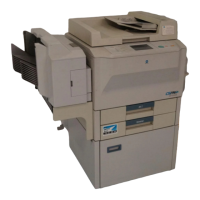Interleaf EP5000/EP4000 GENERAL, MECHANICAL/ELECTRICAL
97.04.01
M-3
6. Paper Feeding
Paper is fed either automatically from the 1st or 2nd Drawer, or manually via the Multi Bypass
Table or Manual Bypass Table. Paper separation is accomplished by the torque limiter fitted to
the Paper Separator Roll.
(For more details, see “18. PAPER TAKE-UP/FEED SECTION”.)
7. Image Transfer
The single-wire Image Transfer Corona Unit applies a DC negative corona emission to the
underside of the paper, thereby attracting toner onto the surface of the paper.
(For more details, see “14. IMAGE TRANSFER AND PAPER SEPARATION”.)
8. Paper Separation
The single-wire Paper Separator Corona Unit applies an AC corona emission to the underside
of the paper to neutralize the paper. In addition, mechanical paper separation is provided by
the two PC Drum Paper Separator Fingers fitted to the Imaging Unit.
(For more details, see “14. IMAGE TRANSFER AND PAPER SEPARATION”.)
9. Cleaning
Residual toner on the surface of the PC Drum is scraped off by the Cleaning Blade.
(For more details, see “16. CLEANING UNIT”.)
10. Main Erase
Light from the Main Erase Lamp neutralizes any surface potential remaining on the surface of
the PC Drum after cleaning.
(For more details, see “17. MAIN ERASE LAMP”.)
11. Transport
The paper is fed to the Fusing Unit by the Suction Belts.
(For more details, see “22. PAPER TRANSPORT”.)
12. Fusing
The developed image is permanently fused to the paper by a combination of heat and
pressure applied by the Upper and Lower Fusing Rollers.
(For more details, see “23. FUSING UNIT”.)
13. Paper Exit
After the fusing process the paper is fed out by the Paper Exit Roller onto the Copy Tray.
(For more details, see “24. EXIT UNIT”.)

